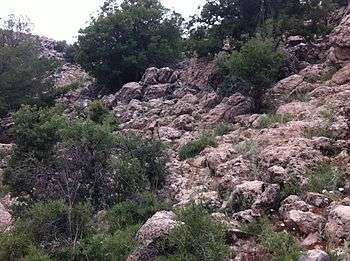Israeli Special Forces Units
| State of Israel |
|---|
 |
|
Special forces units in the Israel Defense Forces encompass a broad definition of specialist units. Such units are usually a company or a battalion in strength.
Sayeret (Hebrew: סיירת, pl.: sayarot), or reconnaissance units in the Israel Defense Forces (IDF) nomenclature, specialize in intelligence gathering and surveillance. In practice, these units specialize in commando and other special forces roles, in addition to reconnaissance (the degree of specialization varies by units and current needs).
Mista'arvim (Hebrew: מסתערבים, lit. Arabized; Arabic: مستعربين, Musta'arabin), also spelled as mistaravim, is the name given to those counter-terrorism units in whose members are specifically trained to operate undercover, in enemy territory, in order to assassinate or capture wanted terrorists.
Special forces units in the IDF

Unit 101
Commando Unit 101, the founding Israeli special forces unit, was established and commanded by Ariel Sharon on orders from Prime Minister David Ben-Gurion in August 1953.[1] They were armed with non-standard weapons and tasked with carrying out retribution operations across the state's borders—in particular, establishing small unit maneuvers, activation and tactical insertion and exit tactics.
Members of the unit were recruited only from agricultural Kibbutzs and Moshavs. Membership in the unit was by invitation only, and any new member had to be voted on by all existing members before they were accepted.[2]
The unit was merged into the 890th Paratroop Battalion during January 1954, on orders of General Dayan, Chief of Staff, because he wanted their experience and spirit to be spread among all infantry units of IDF starting with the paratroopers. They are considered to have had a significant influence on the development of subsequent Israeli special forces units.[3]
Sayeret units today
All combat brigades in the IDF have a unit with improved weaponry and training used for reconnaissance and special forces missions, trained to use advanced weapons and reconnaissance technology, as well as hand-to-hand combat. Historically the brigades used to only have one company-sized unit outfitted to do this job, known as Palsar (Hebrew contraction of: פלוגת-סיור, Plugat Siyur (singular) / Plugot Siyur (plural), "Reconnaissance Company"). Although the Palsar are mostly oriented at battlefield support (which is their raison d'être), many have participated in special operations during recent years. All infantry units as well as some armored units have Palsar.

While in the past there were differences between the Siyur units, due to the experiences of the past decades the IDF is now consolidating them into larger units with many different capabilities: battalion-sized units called Gadsar (contraction of Gdud Siyur, "Reconnaissance battalion"). Each Gadsar is made up of three specialized Plugot (companies): Demolitions and combat engineering (Plugat Habalah Handasit, or Palhan), Reconnaissance (Plugat Siyur, Palsar) and Anti-Tank (Pluga Neged Tankim, or Palnat).
This is part of the Yatah ("Low-Intensity Combat Unit") Project. This project aims at changing the Reconnaissance battalions into specialized urban counter terror units, that are specifically trained and equipped to operate in current combat situations.
On late December 2015, some Ground Force special forces units have been assembled in the Oz Brigade.[5][6]
Other SF units or Sayarot are larger units, operating under corps and commands. There are several battalion-size units which report directly to regional, functional (navy/air-force) and the general commands. The best known of these are Sayeret Matkal, Shayetet 13 and Shaldag.
IDF units
Main special forces units
These are the most well-known commando units. Their operators are proficient in long range solo navigation, as opposed to other units where long range navigation is done with a minimum of 2 fighters.
- Sayeret Matkal – the IDF's principal Sayeret unit, used mainly to obtain strategic intelligence behind enemy lines and to perform hostage-rescue missions on foreign soil. It is directly subordinate to the Israeli Military Intelligence Directorate (AMAN).
- Shayetet 13 – the naval commando unit, equivalent to the US Navy SEALs or British Special Boat Service. Also tasked with maritime hostage-rescue missions. Part of the Israeli Navy. Founded in 1948 by former members of the Palyam, the naval branch of the Haganah.
- Shaldag – founded in 1974 by several former Sayeret Matkal veterans, it is the Israeli Air Force's commando unit, specializing in forward air control, aerial & special reconnaissance, and target designation outside of Israel's borders.
Commando Brigade "Oz"
- Duvdevan – mistaravim unit operating in the West Bank.
- Egoz – counter-guerrilla unit, originally for operating in southern Lebanon.
- Maglan – a commando unit which specializes in operating behind enemy lines.
- Rimon Reconnaissance Unit – desert warfare unit.
Infantry Corps

The five infantry brigades (Golani, Givati, Nahal, Kfir and the Paratroopers) operate their own Palsars (today joint with Pal'nat and Pal'han as "Gad'sar"/Gdoud Siour), the infantry "Sayarot". Each unit is subordinate to a specific regiment command, though they are not restricted to these.
- Gad'sar Golani (Northern Command).
- Gad'sar Tzanhanim (paratroopers) (Central Command)
- Gad'sar Nahal (Central Command).
- Gad'sar Kfir (Central Command).
- Gad'sar Givati (Southern Command).
Armored Corps
- Palsar 7 – the 7th Armored Brigade reconnaissance unit.
- Palsar 188 – the 188th Armored Brigade reconnaissance unit.
- Palsar 401 – the 401st Brigade reconnaissance unit.
Artillery Corps
- Meitar/Moran – a unit operating long range precision-guided missiles.
- Sky Rider (רוכב שמיים) – a combat unit operating the Elbit Skylark drone.
Combat Engineering Corps
- Sayeret Yahalom – the engineering special forces unit, its missions range from EOD and bomb disposal to counter-mining warfare.
Combat Intelligence Collection Corps
- Yachmam – special forces detachments belonging to the Corps. Also known as "Target Intelligence Units" due to their wartime role of target acquisition.
Air Force
- Unit 669 – combat search and rescue unit.
- Unit Yanmam – airborne-capable anti-aircraft unit.
- Unit 5700 – aircraft landscape and desert specialist.
- Airplane Security Unit – force protection unit
Navy
- Shayetet 7 – the submarine unit.
- Unit Yaltam – salvage and recovery unit.
- Unit Snapir – force protection unit (allows female fighters).
Other units
- LOTAR Eilat – reserve force counter-terrorism/hostage-rescue unit based at the southern Israeli port city of Eilat.
- General Staff Security Unit – bodyguard unit of the Chief of General Staff and other top diginitaries.
- Alpinist – IDF mountain-warfare unit operating in the Golan Heights; provides protection for IDF electronic listening posts on Mount Hermon and Mt. Avital. This unit also provides alpine rescue services.
- Oketz – the IDF's special K-9 unit.
Disbanded units
- Unit 101 – the first Israeli special forces unit, commanded by Ariel Sharon.
- Samson Unit – former Gaza Strip counter-terrorist unit.
- Sayeret Haruv – former IDF Central Command special forces unit.
- Sayeret Shaked – former IDF Southern Command special forces unit.
Law enforcement units
Border Police
- Yamam – the main unit in charge of counter-terrorist and hostage-rescue missions inside Israel, with the exception of the city of Eilat.
- Yamas – special operations and mista'arvim unit directly subordinate to the Shin Bet.
Police
- Yasam – quick response and riot police unit.
- Gideonim – undercover and mistaravim unit.
- YAGAL – counter-smuggling unit.
- Special units for the protection of public transportation.
Prison Service
- Masada – quick response and intervention force and specializes in suppression of prisoner uprisings, especially in prisons containing Palestinian prisoners.
- Nahshon – intervention and conveyance unit; deals with searches, silencing disturbances, guarding IPS staff, etc.
- Dror – counter-narcotics unit
Gibush (Selection)
Young Israelis wanting to serve in the sayarot usually go to Yom Sayarot (Reconnaissance Units Day). Held at the Wingate Institute, Yom Sayarot is a day where prospective recruits undergo a series of physical and mental tests to evaluate their aptitude for service in several units. Those wanting to join Sayeret Matkal, Shaldag, Unit 669, Shayetet 13, the submarine service or Hovlim (Naval Officers Course) must go to Yom Sayarot and perform the respective tests for each service option.
Other sayarot recruit their operatives from the best recruits of the respective parent units. For instance, those who excel during training in the Paratroopers Brigade are invited to try to join Duvdevan, Maglan or the Special Forces battalion of the brigade; the best of recruits of the Armored Corps are invited to apply for service in the Armored reconnaissance units, etc.
Drop-outs from some sayarot might be able join other, less demanding sayarot units. For instance, drop-outs from Shayetet 13 might be able to go to Unit Yaltam or Yaban; drop-outs from Shaldag can end up in Unit Yanmam.
The reserve sayarot such as Alpinistim or LOTAR Eilat usually recruit its members after they finished the mandatory 3-year service in some units: Alpinistim draws its members primarily from Golani and LOTAR Eilat draws its members from former kravi (soldiers that served in a combat unit) that live in Eilat.
See also
- Mossad – Israel's covert intelligence and special operations agency.
- Kidon – a department within Mossad that is allegedly responsible for assassination.
- Aman – Israel's military intelligence agency.
- Shin Bet – Israel's internal security agency.
- Isayeret
- Oz Brigade – the Ground Forces formation grouping some of the Israeli special forces units.
References
- ↑ "Unit 101". Specwar.info. Retrieved 2009-09-04.
- ↑ Like Dreamers, by Yossi Klein Halevy, (New York 2013), pages 42–43
- ↑ "Jewish Virtual Library — Israeli Special Forces History". Retrieved 2009-09-04.
- ↑ Morris, Benny (1993) Israel's Border Wars, 1949–1956. Arab Infiltration, Israeli Retaliation, and the Countdown to the Suez War. Oxford University Press, ISBN 0-19-827850-0. Page
- ↑ Zeff, Michael (27 December 2015). "New Israeli Special Operations Infantry Brigade". Special Forces International. Tazpit News Agency. Retrieved 14 January 2016.
- ↑ http://www.timesofisrael.com/idfs-new-commando-brigade-completes-first-exercise/